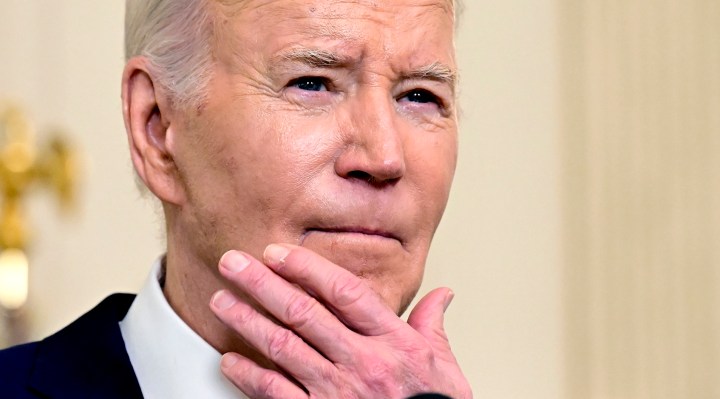Business Maverick
Biden set to impose tariffs on China EVs, strategic sectors

President Joe Biden’s administration is poised to unveil a sweeping decision on China tariffs as soon as next week, one that’s expected to target key strategic sectors while rejecting the across-the-board hikes sought by Donald Trump, people familiar with the matter said.
The decision is the culmination of a review of so-called Section 301 tariffs first put into place under Trump starting in 2018. The new tariffs will focus on industries including electric vehicles, batteries and solar cells, with existing levies largely being maintained. An announcement is scheduled for Tuesday, two of the people said.
While a decision could be delayed, it nonetheless represents one of Biden’s biggest moves in the economic race with China. It builds on his call last month to hike tariffs on Chinese steel and aluminum, and the formal launch of a fresh probe into China’s shipbuilding industry.
The CSI 300 Index, a benchmark of onshore Chinese shares, fell as much as 0.6% in early trading before paring about half of its decline. China’s Foreign Ministry and Commerce Ministry didn’t immediately reply to requests for comment on Friday morning local time.
“It’ll definitely cause investors to pause on stocks that are potentially exposed,” said Xin-Yao Ng, director of investment at abrdn, adding that many green-tech brands such as battery giant Contemporary Amperex Technology Co. have already limited their US exposure. “Everyone knows it’s a risk.”
President Xi Jinping’s strategy of ramping up manufacturing to arrest an economic slowdown at home has triggered alarm abroad. US and European Union leaders have scolded Beijing over state subsidies, which they say have fueled a deluge of cheap exports that are threatening jobs in their markets.
The US is standing up to China’s “unfair economic practices and industrial overcapacity,” Biden said last month. “I’m not looking for a fight with China. I’m looking for competition, but fair competition.”
The tariffs would likely have little immediate impact on Chinese firms, as its world-beating EV giants are mostly locked out of the American market by auto tariffs. Its solar companies mostly export to the US from third countries to avoid curbs, with US firms seeking higher tariffs on that trade, too.
Biden and his challenger Donald Trump are both jockeying to be seen as tough on China, as they head toward an election rematch in November. Biden last month signed into law a bill that began a countdown for video-sharing platform TikTok to divest from its Chinese parent ByteDance Ltd., or quit the American market.
Trump has promised to hike tariffs on China across the board if reelected, vowing a 60% tax on all Chinese imports. Many Democrats have dismissed that approach, in part because it would raise prices for US consumers grappling with inflation.
During Trump’s last administration, Washington and Beijing became embroiled in a tit-for-tat trade war, which saw China retaliate with measures that aimed to exact pain in the American heartland by targeting agricultural exports.
US Senator Chuck Grassley, an Iowa Republican, said he expects Beijing to respond. “We know how China reacted when Trump put tariffs on,” he added. “They hit agriculture with it. I can’t be sure that China would hit agriculture the same as they did in the Trump ones, but they’re going to hit back.”
Strategic tariffs
Biden’s announcement would be formally enacted by the office of US Trade Representative Katherine Tai, who last month said that she expected a conclusion to a review that began in 2022 to end “soon”. The administration had been looking at ways to make the tariffs more strategic and effective, she added.
The move comes after Biden last month proposed new 25% tariffs on Chinese steel and aluminum, part of a series of steps to shore up the American steel sector and woo its workers in an election year. That vow was viewed as largely symbolic, because China currently exports little of either metal to the US.
Beijing responded with restraint to the threat of metal curbs, imposing tariffs on US propionic acid, an export market worth $7-million to America last year, according to customs data. Still, ramping up tariffs on a broader spectrum of industries could prompt a stronger response from Chinese officials.
The full range of existing duties spans imports from industrial inputs, such as microchips and chemicals, to consumer merchandise including apparel and furniture. Trump imposed the first of the tariffs in 2018, citing section 301 of the Trade Act of 1974.
For years, internal divisions prevented Biden’s team from arriving at a consensus on what to do about the tariffs. Some officials including Treasury Secretary Janet Yellen had argued that reducing curbs on household items could help ease US inflation.
While the Biden administration had considered the political implications of changes to the tariffs, USTR in late 2022 began a legally required formal review of their impact. In the absence of such an evaluation, the curbs would have started to automatically expire in mid-2022.
Under Trump, Washington and Beijing reached the so-called phase one agreement in early 2020. That reduced some duties in exchange for China pledging to address intellectual-property theft and increase its purchases of energy, farm and manufactured goods along with services by $200 billion in the two years through the end of 2021. China fell more than one third short of its promises.
Biden’s tariff move comes after his nation’s turbulent relationship with China has stabilized in recent months amid a flurry of diplomatic engagements. After the US president met his Chinese counterpart in California last November, Biden said they had achieved “real progress.”


















Comments - Please login in order to comment.